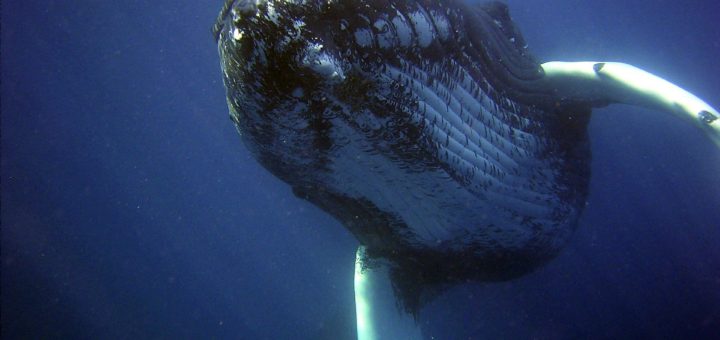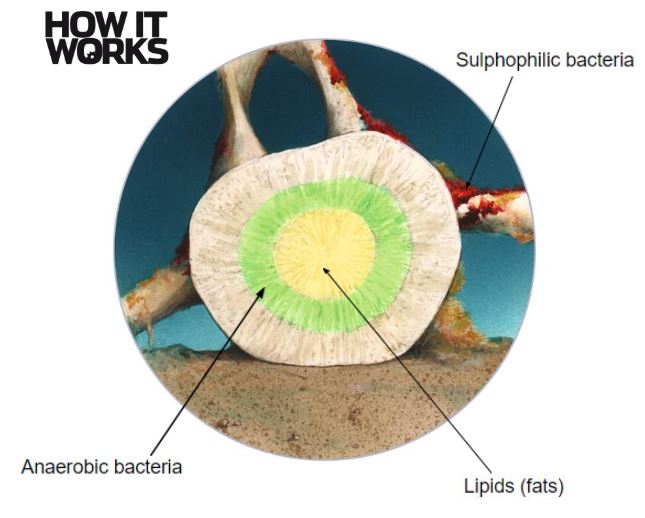How does a whale’s death bring new life?
by Ailsa Harvey · 21/06/2020
The body of a whale can support millions of deep sea organisms

(Image source: Pixabay)
On an average day, creatures living in the depths of the ocean rely on ‘marine snow’ – a slow trickle of nutrients from the surface. Every so often, however, a huge feast falls several kilometres through the water and comes to rest on the seabed. The enormous carcass of a whale supports a variety of creatures – from microbes to sharks – for decades, with every part ultimately consumed.
The body of a whale can support millions of deep sea organisms The first hint of the importance of whale
falls came from a paper published in 1900, documenting the discovery of a small mussel clinging to a whalebone picked up by trawlermen. It wasn’t until decades later that the first full skeleton was spotted by divers. At the time they described it as looking like the remains of a dinosaur, but it was soon identified as a whale, and bones were collected for research.
There are three successive stages in the whale fall ecosystem, each made up of a community making use of certain parts of the carcass. The stages can overlap as different creatures are drawn to the scent of the body, but the third and final stage is perhaps the most fascinating; it’s the most diverse community known to exist on the seafloor.
The discovery of large numbers of fossilised clams around 30-million-year-old whale bones suggests that whale fall ecosystems have existed for as long as there have been whales in the ocean. As many of the species found at whale falls are specially adapted to life on whale carcasses, they must travel from
body to body as food runs out in order to survive. While humans rarely come across whale falls, experts believe they might occur as commonly as one every five kilometres off the coast of North America.
Stages of whale decay

(Illustration: The Art Agency/Peter Scott)
1: Scavenger stage
A newly fallen whale’s soft tissues provide a couple of years’ worth of food for larger scavenging
creatures. As the scavengers chew on the meat they expose the inside of the carcass.
- When a whale lands on the seabed, the smell of its carcass drifts through the water and alerts bottom-dwellers to the bounty of food.
- The first creatures on the scene are the scavengers, such ratfish, sharks and eel-like hagfish, which feed on skin, muscle and blubber
2: Opportunists arrive
When the large animals have eaten their fill, smaller scavengers arrive to clear up what’s left of the blubber and get to work on the other body parts.
- Any leftover blubber is found and eaten by the second wave of scavengers, which includes molluscs, crustaceans and bristle worms.
- Once the skeleton is exposed, zombie worms move in and begin to burrow into the whale’s bones.
- As the whale’s soft tissue is being eaten, oil seeps into the surrounding seabed. The nutrient-rich sediment can feed opportunists for several years.
3: Time of the sulphur lovers
Anaerobic bacteria feeding on the remaining scraps produce the hydrogen sulphide needed by other bacteria, which in turn serve as food for larger organisms in a self-contained food web. This stage can take place for up to 50 years.
- Sulphophilic – sulphur-loving – bacteria use the sulphides produced in the breakdown of the bones to create energy and power their own cells.
- When only the skeleton remains, anaerobic (breathes without oxygen) bacteria begin to break down lipids in the bones and release sulphides.
- Some sulphophilic bacteria live inside other organisms like clams, mussels and tube worms, providing energy for their hosts in exchange for a safe home.
- Mats of sulphophilic bacteria living on the whale’s skeleton are hoovered up by creatures such as limpets and bristle worms.

(Illustration: The Art Agency/Peter Scott)
This article was originally published in How It Works issue 126, written by Victoria Williams
For more science and technology articles, pick up the latest copy of How It Works from all good retailers or from our website now. If you have a tablet or smartphone, you can also download the digital version onto your iOS or Android device. To make sure you never miss an issue of How It Works magazine, subscribe today!




